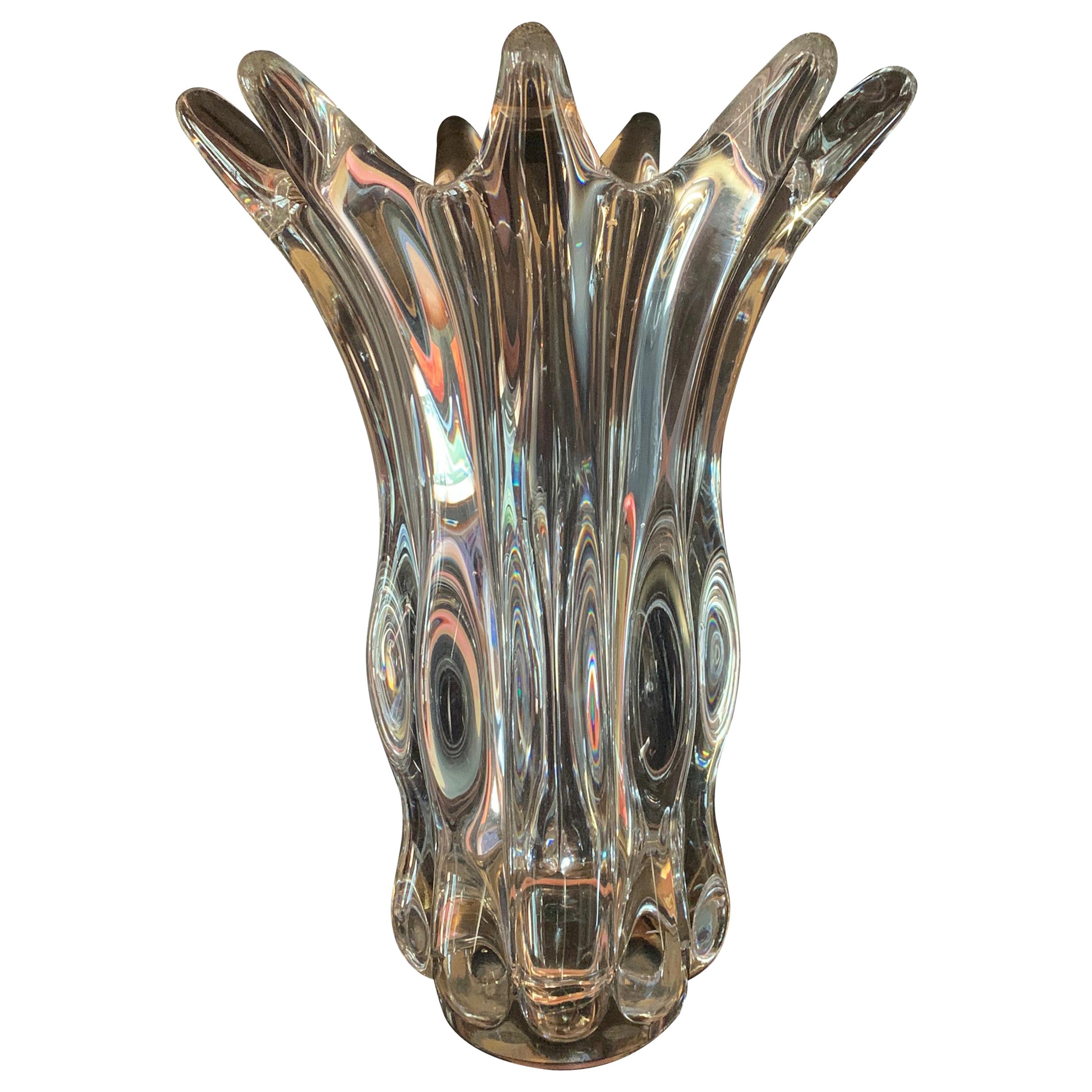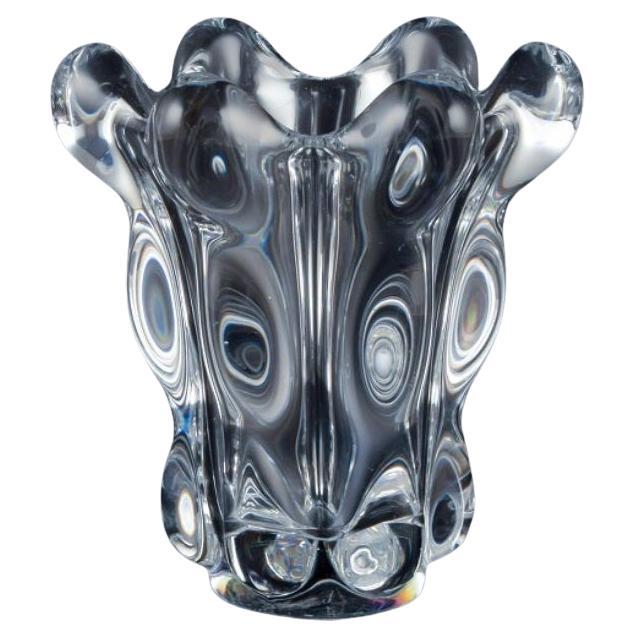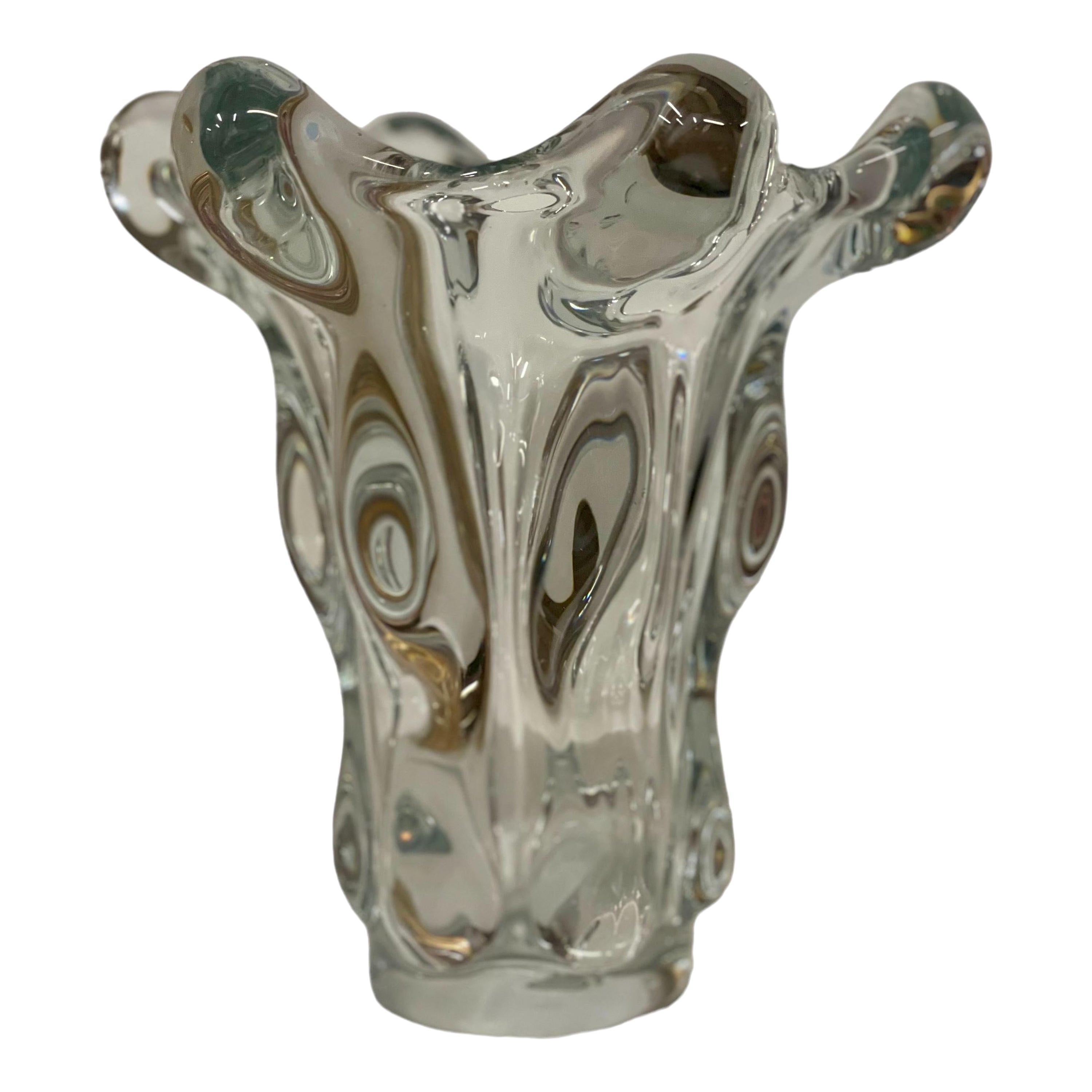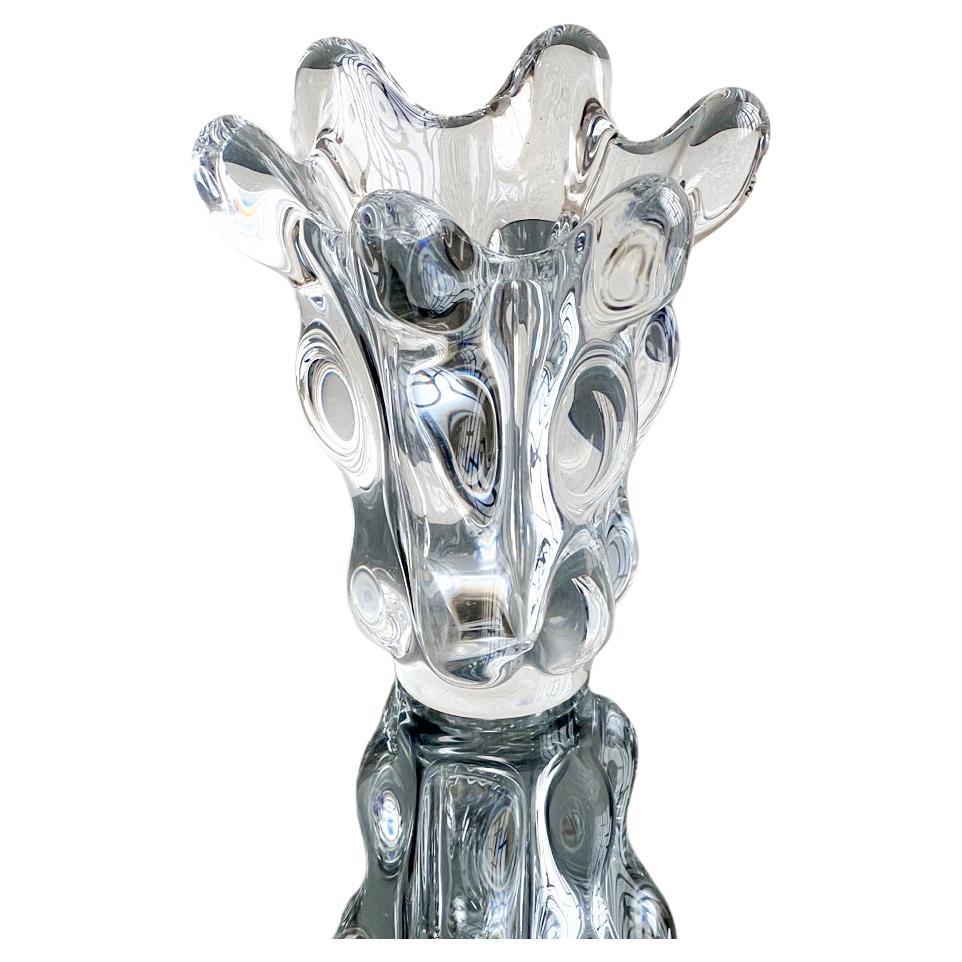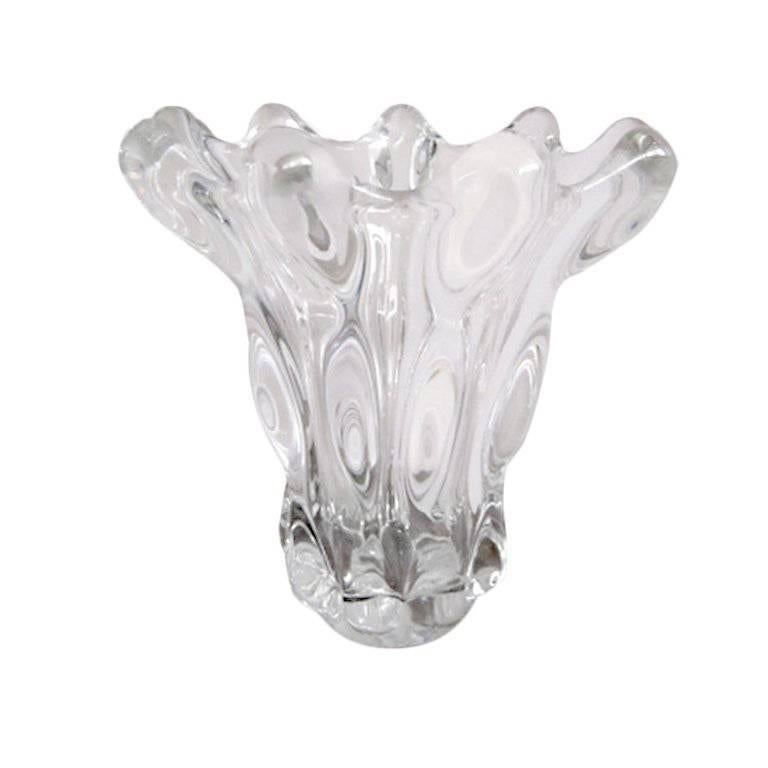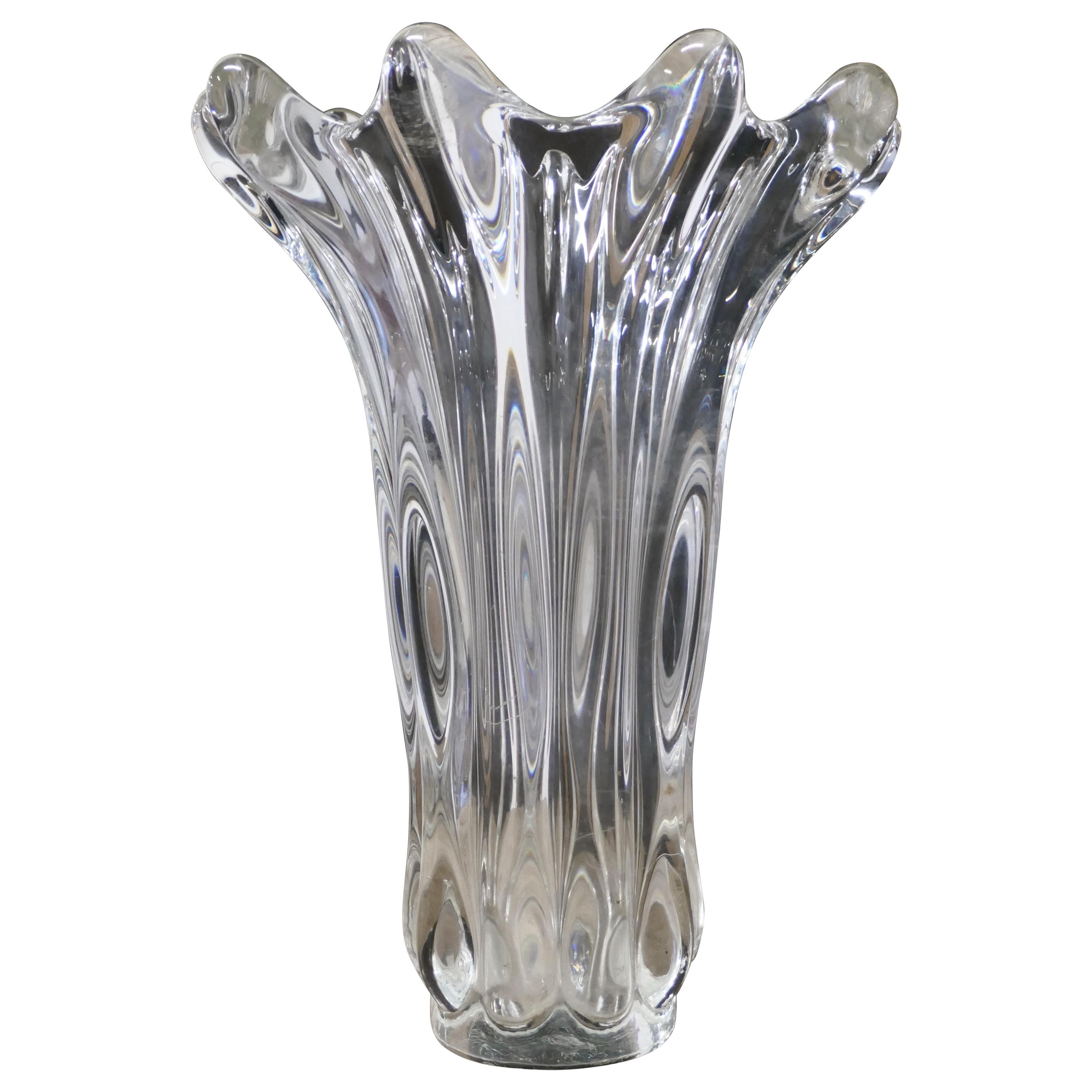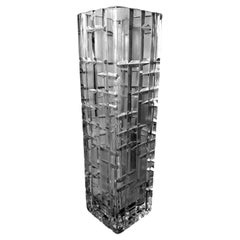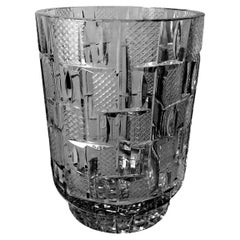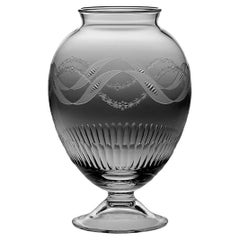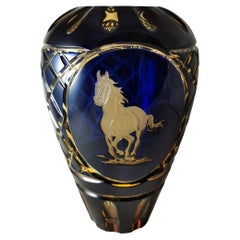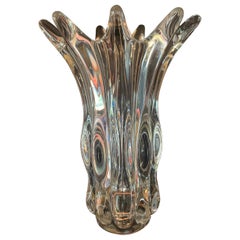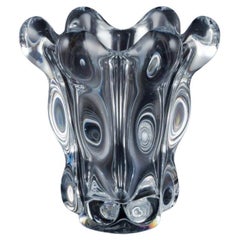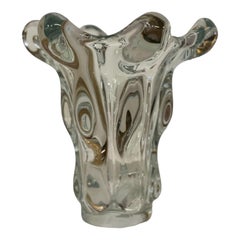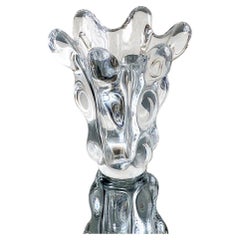Items Similar to Art Deco, French Lead Crystal Vase In The Vannes-Le-Châtel Style
Video Loading
Want more images or videos?
Request additional images or videos from the seller
1 of 18
Art Deco, French Lead Crystal Vase In The Vannes-Le-Châtel Style
$441.38
£326.32
€370
CA$607.11
A$674.84
CHF 353.74
MX$8,241.40
NOK 4,416.18
SEK 4,154.81
DKK 2,816.80
About the Item
We kindly invite you to read the full description, as it offers detailed technical and historical information to assure you of the authenticity of our pieces.
This is an exceptional and significant clear lead crystal vase. Its shape, characterized by gentle curves and rounded edges, captivates with unparalleled elegance, fluidity, and lightness. Master craftsmen managed to transform a substantial block of crystal into something delicate and almost ethereal by skillfully working it by hand through twisting, pinching, and shaping. The vase was crafted between 1955 and 1960 in one of the many workshops in the Vannes-le-Châtel area of the Lorraine region, part of France’s Grand Est, known for its distinguished crystal and glass production. The renowned Vannes-le-Châtel Cristalleries was based in this region and employed local artisans in workshops outside the company itself. We can confidently state that our vase was created in one of these workshops and sold without the Vannes mark but with the same aesthetic and quality traits that defined the company. The history of Vannes Crystalworks dates back to approximately 1765 when it was founded under aristocratic patronage. It quickly became one of France's leading glass manufacturers, initially focusing on tableware and branching out into decorative works by 1930. In 1963, it began producing decorative lead crystal, reaching its peak from 1960 to 1970. The Vannes glassworks eventually became part of the Compagnie Française du Cristal (CFC), which later merged with Daum under the name CFC Daum. Nevertheless, the prestigious pieces produced during that era, while of exceptional quality, did not bear the Daum mark but rather that of Vannes. Around 1970, ART Vannes ceased production, leading to the establishment of Cristal de Sèvres, and only from 1980 onward were the pieces branded Daum.
Regardless of the various markings, glass, and crystal masterpieces from the Vannes-le-Châtel area hold a significant place in French decorative history.
Measurements: diameter 18 cm, height 18 cm. The vase is in good condition.
We use special packaging materials (wooden crates, Styrofoam, etc.) for all shipments to ensure the highest level of protection and safety for the items.
- Similar to:Art Vannes (Maker)
- Dimensions:Height: 6.3 in (16 cm)Diameter: 7.09 in (18 cm)
- Style:Art Deco (In the Style Of)
- Materials and Techniques:
- Place of Origin:
- Period:
- Date of Manufacture:1955-1960
- Condition:Wear consistent with age and use. The vase is in good condition.
- Seller Location:Prato, IT
- Reference Number:Seller: 165141stDibs: LU4632243004812
About the Seller
5.0
Platinum Seller
Premium sellers with a 4.7+ rating and 24-hour response times
Established in 1977
1stDibs seller since 2019
286 sales on 1stDibs
Typical response time: 1 hour
- ShippingRetrieving quote...Shipping from: PRATO, Italy
- Return Policy
Authenticity Guarantee
In the unlikely event there’s an issue with an item’s authenticity, contact us within 1 year for a full refund. DetailsMoney-Back Guarantee
If your item is not as described, is damaged in transit, or does not arrive, contact us within 7 days for a full refund. Details24-Hour Cancellation
You have a 24-hour grace period in which to reconsider your purchase, with no questions asked.Vetted Professional Sellers
Our world-class sellers must adhere to strict standards for service and quality, maintaining the integrity of our listings.Price-Match Guarantee
If you find that a seller listed the same item for a lower price elsewhere, we’ll match it.Trusted Global Delivery
Our best-in-class carrier network provides specialized shipping options worldwide, including custom delivery.More From This Seller
View AllItalian Craftsmanship Hand-Cut and Hand-Polished Beveled Crystal Vase
Located in Prato, Tuscany
We kindly suggest that you read the entire description, as we aim to provide detailed technical and historical information to guarantee the authenticity of our objects. This exceptio...
Category
Late 20th Century Italian Modern Vases
Materials
Crystal
Italian Midcentury Large Crystal Vase Ground, Cut, And Polished By Hand
Located in Prato, Tuscany
Please kindly read the entire description, as we aim to provide you with detailed technical and historical information to ensure the authenticity of our objects.
This exceptional Ita...
Category
Late 20th Century Italian Mid-Century Modern Vases
Materials
Crystal
Neoclassical Style Italian Crystal Vase With Festoon Engravings
Located in Prato, Tuscany
Before describing the object under consideration we must make an important clarification; the artifact, one of many that we will publish over time, is part of the museum collection of a historic Florentine crystal grinder that unfortunately closed recently. It is the Marcello Galgani & Son company, whose completely manual and artisanal work has not withstood the disproportionate advance of mass-produced mechanical processes! Marcello Galgani began his craft as a grinder and restorer in 1960; as the years went by, Marcello mastered and became familiar with particular techniques and shapes, resulting in the production of objects that manage to retain the freshness of grinding and engraving, the warmth and softness of light, and the inimitable flavor of unique artifacts. After several years, his son Lorenzo, who grew up among crystals, also entered the business and immediately became passionate about this ancient craft with skill and ability. Stimulated by the aesthetic sense of the past, father and son, set up a workshop in which the shapes they researched and created themselves are mouth-blown by traditional Tuscan glassmakers in Empoli, then ground and engraved using ancient sixteenth-century techniques, with motifs born of the Galgani's inexhaustible imagination or culturally inspired by designs of objects seen and studied in Florentine museums (Uffizi, Galleria Palatina, Museo degli Argenti, etc.). Marcello and Lorenzo Galgani were also Masters in the difficult art of restoration, bringing rare and precious objects back to life. As mentioned the company recently closed and disposed of all its last production, only Marcello's old private museum collection remained, which includes unique and special objects created over time, a collection that the craftsman made available to us for a planned sale. All of the objects were made entirely by hand with old grinding wheels, but there were mainly two tools that allowed the creation of masterpieces: the right hand and the left hand of the master craftsman. Ancient glassmaking techniques were used for all the ground and engraved products: first the object was ground with an emery wheel fed continuously by a jet of abrasive sand and water, then re-polished with a very fine-grained sandstone wheel also fed with water; the engravings were done freehand using as many as 10-15 small stone wheels for each design (flowers, branches, animals, etc. ); then the object was polished and shined; we must make, at this point, an important clarification on these last two operations: towards the end of the 1960s acid crystal polishing was devised, the object was immersed and rotated in a solution of sulfuric acid, fluoridic acid and water and in a short time all the defects left by the previous processes were eliminated, it was a fast, industrial operation that allowed to lower costs considerably, with discrete but not excellent results. But for Galgani's products polishing is done with a cork bark wheel wet with water and pumice, to make the surfaces more transparent. Finally, polishing was achieved with a felt wheel wet with a paste of water, iron oxide, and cerium oxide. This series of processes takes an average of two days of work( sometimes much longer) for each object, each engraving or grinding is the result of the creative inventiveness of the two craftsmen, inventiveness that transforms crystal into a material reality of the highest aesthetic value and inestimable value. All objects in the entire collection have never been used; they were part of the exhibition. Large oval crystal vase...
Category
Late 20th Century Italian Neoclassical Vases
Materials
Crystal
Art Deco Large Italian Bi-Color Crystal Vase Cut And Ground By Hand
Located in Prato, Tuscany
Before describing the object under consideration we must make an important clarification; the artifact, one of many that we will publish over time, is part of the museum collection o...
Category
Late 20th Century Italian Art Deco Vases
Materials
Crystal
Baroque Style Large Italian Crystal Vase With Grotesque Engravings
Located in Prato, Tuscany
Before describing the object under consideration, we must make an important clarification; the artifact, one of many that we will publish over time, is part of the museum collection of a historic Florentine crystal grinder that unfortunately closed recently. It is the Marcello Galgani & Son company, whose completely manual and artisanal work has not withstood the disproportionate advance of mass-produced mechanical processes! Marcello Galgani began his craft as a grinder and restorer in 1960; as the years went by, Marcello mastered and became familiar with particular techniques and shapes, resulting in the production of objects that manage to retain the freshness of grinding and engraving, the warmth and softness of light, and the inimitable flavor of unique artifacts. After several years, his son Lorenzo, who grew up among crystals, also entered the business and immediately became passionate about this ancient craft with skill and ability. Stimulated by the aesthetic sense of the past, father and son, set up a workshop in which the shapes they researched and created themselves are mouth-blown by traditional Tuscan glassmakers in Empoli, then ground and engraved using ancient sixteenth-century techniques, with motifs born from the Galgani's inexhaustible imagination or culturally inspired by designs of objects seen and studied in Florentine museums (Uffizi, Galleria Palatina, Museo degli Argenti, etc.). Marcello and Lorenzo Galgani were also Masters in the difficult art of restoration, bringing rare and precious objects back to life. As mentioned the company recently closed and disposed of all its last production, and only Marcello's old private museum collection remained, which includes unique and special objects created over time, a collection that the craftsman made available to us for a planned sale. All of the objects were made entirely by hand with old grinding wheels, but there were mainly two tools that allowed the creation of masterpieces: the right hand and the left hand of the master craftsman. Ancient glassmaking techniques were used for all the ground and engraved products: first, the object was ground with an emery wheel fed continuously by a jet of abrasive sand and water, then re-polished with a very fine-grained sandstone wheel also fed with water; the engravings were done freehand using as many as 10-15 small stone wheels for each design (flowers, branches, animals, etc. ); then the object was polished and shined; we must make, at this point, an important clarification on these last two operations: towards the end of the 1960s acid crystal polishing was devised, the object was immersed and rotated in a solution of sulfuric acid, fluoridic acid and water and in a short time all the defects left by the previous processes were eliminated, it was a fast, industrial operation that allowed to lower costs considerably, with discrete but not excellent results. But for Galgani's products polishing is done with a cork bark wheel wet with water and pumice, to make the surfaces more transparent, and finally polishing was achieved with a felt wheel wet with a paste of water, iron oxide, and cerium oxide. This series of processes takes an average of two days of work( sometimes much longer) for each object, each engraving or grinding is the result of the creative inventiveness of the two artisans, inventiveness that transforms crystal into reality material of the highest aesthetic value and inestimable value. All the items in the entire collection have never been used; they were part of the exhibition. Large crystal vase; the decorations, in baroque style represent a series of "grotesques" The object is "a unique piece" signed by the Master, it was created in Marcello Galgani's workshop in 1983 and made with the techniques (grinding, engraving and polishing) that we explained in the description; for the shape, the Master was inspired by a vase present in a painting, preserved in the Uffizi Gallery in Florence by the sixteenth-century painter Jacopo Ligozzi...
Category
Late 20th Century Italian Baroque Vases
Materials
Crystal
Florentine Renaissance Style Huge Italian Cut And Ground Crystal Medici Vase
Located in Prato, Tuscany
Before describing the object under consideration, we must make an important clarification; the artifact, one of many that we will publish over time, is part of the museum collection of a historic Florentine crystal grinder that unfortunately closed recently. It is the Marcello Galgani & Son company, whose completely manual and artisanal work has not withstood the disproportionate advance of mass-produced mechanical processes! Marcello Galgani began his craft as a grinder and restorer in 1960; as the years went by, Marcello mastered and became familiar with particular techniques and shapes, resulting in the production of objects that manage to retain the freshness of grinding and engraving, the warmth and softness of light, and the inimitable flavor of unique artifacts. After several years, his son Lorenzo, who grew up among crystals, also entered the business and immediately became passionate about this ancient craft with skill and ability. Stimulated by the aesthetic sense of the past, father and son, set up a workshop in which the shapes they researched and created themselves are mouth-blown by traditional Tuscan glassmakers in Empoli, then ground and engraved using ancient sixteenth-century techniques, with motifs born from the Galgani's inexhaustible imagination or culturally inspired by designs of objects seen and studied in Florentine museums (Uffizi, Galleria Palatina, Museo degli Argenti, etc.). Marcello and Lorenzo Galgani were also Masters in the difficult art of restoration, bringing rare and precious objects back to life. As mentioned the company recently closed and disposed of all its last production, and only Marcello's old private museum collection remained, which includes unique and special objects created over time, a collection that the craftsman made available to us for a planned sale. All of the objects were made entirely by hand with old grinding wheels, but there were mainly two tools that allowed the creation of masterpieces: the right hand and the left hand of the master craftsman. Ancient glassmaking techniques were used for all the ground and engraved products: first, the object was ground with an emery wheel fed continuously by a jet of abrasive sand and water, then re-polished with a very fine-grained sandstone wheel also fed with water; the engravings were done freehand using as many as 10-15 small stone wheels for each design (flowers, branches, animals, etc. ); then the object was polished and shined; we must make, at this point, an important clarification on these last two operations: towards the end of the 1960s acid crystal polishing was devised, the object was immersed and rotated in a solution of sulfuric acid, fluoridic acid and water and in a short time all the defects left by the previous processes were eliminated, it was a fast, industrial operation that allowed to lower costs considerably, with discrete but not excellent results. But for Galgani's products polishing is done with a cork bark wheel wet with water and pumice, to make the surfaces more transparent, and finally polishing was achieved with a felt wheel wet with a paste of water, iron oxide, and cerium oxide. This series of processes takes an average of two days of work( sometimes much longer) for each object, each engraving or grinding is the result of the creative inventiveness of the two artisans, inventiveness that transforms crystal into reality material of the highest aesthetic value and inestimable value. All the items in the entire collection have never been used; they were part of the exhibition. Huge and monumental Florentine Renaissance-style vase...
Category
Late 20th Century Italian Renaissance Vases
Materials
Crystal
You May Also Like
Vannes France Crystal Vase
By Art Vannes
Located in Los Angeles, CA
A stunning crystal vase - 'Made in France', and a compliment any room on a center table, dining table or mantle... The look of water splashing in motion is represented here in great ...
Category
20th Century French Mid-Century Modern Vases
Materials
Crystal
Art Vannes, France. Art glass vase in crystal. Art Deco.
Located in København, Copenhagen
Art Vannes, France. Art glass vase in crystal. Art Deco.
Clear glass. Handmade.
1930s/40s.
Marked.
Perfect condition.
Dimensions: H 15.0 cm. x D 13.8 cm.
Category
Vintage 1930s French Modern Vases
Materials
Crystal
Large Crystal Vase by Art Vannes
By Art Vannes
Located in LA CIOTAT, FR
A fabulous and quirky heavy blown French crystal vase, made by renowned crystal manufacturer Art Vannes, and dating from around the middle of the 20th century. Heavy and substantial,...
Category
20th Century French Vases
Materials
Crystal
Vintage French Glass Vase, Signed Art Vannes, 1950s Decorative, Collectible
By Art Vannes
Located in Milano, IT
Decorative Glass Vase - Art Vannes Vintage Vase - Mid Century French Glass
Fluid and highly decorative French vase in clear crystal glass. Acid-signed “Art Vannes” underneath the ba...
Category
Vintage 1950s French Mid-Century Modern Glass
Materials
Glass, Art Glass, Blown Glass
$419 Sale Price
20% Off
Large Vannes Crystal Vase
Located in Brooklyn, NY
original large Vannes crystal vase.
Category
Vintage 1950s French Vases
Materials
Crystal
Midcentury Hand Blown Crystal Vase by Art Vannes
Located in Godshill, Isle of Wight
Midcentury hand blown crystal vase by Art Vannes
A stunning very heavy piece in natural crystal in a stylized floral shape design, made ...
Category
Vintage 1950s Art Deco Glass
Materials
Crystal
More Ways To Browse
1960 Art Deco
1970 Art Deco
Leaded Glass Art
Crystal Bear
Block Crystal Glasses
Vannes Crystal
Art Vannes France
Art Vannes Crystal
Sevres Crystal Vase
Daum Cristal
Crystal Block Vase
Vannes French Crystal Vases
Vannes Le Chatel
Crystal Vase By Art Vannes
Vannes Le Chatel Crystal
Sevres Cristal
Italian Floral Pottery
Middle Eastern Vessel
